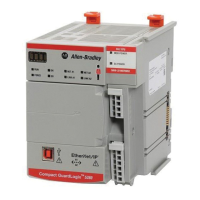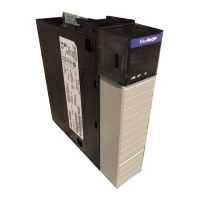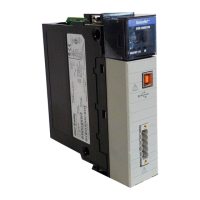Rockwell Automation Publication MOTION-RM003I-EN-P - February 2018 217
Enumerated value that controls operation of the Adaptive Tuning function. This
function periodically collects axis torque data and analyzes this data to identify
resonances and closed loop instabilities in the system.
When Adaptive Tuning Configuration is Disabled the configured values for all
servo loop attributes of the associated axis are applied directly without
intervention of the Adaptive Tuning function.
When configured for Tracking Notch, the Torque Notch Filter Frequency
Estimate attribute value, determined by the Adaptive Tuning function, is applied
to the Torque Notch Filter as part of the control loop update. The configured
Torque Notch Filter Frequency attribute is not overwritten as a result of this
operation. All other servo loop attributes are applied directly without intervention
of the Adaptive Tuning function.
When configured for Gain Stabilization, the Load Observer Bandwidth, Load
Observer Integrator Bandwidth, Velocity Loop Bandwidth, Velocity Loop
Integrator Bandwidth, Position Loop Bandwidth, and Position Loop Integrator
Bandwidth attribute values are scaled by the Adaptive Tune Gain Scaling Factor as
part of the control loop update. The configured values of these attributes are not
overwritten as a result of this operation. The Torque Low Pass Filter Bandwidth
Estimate is also applied to the Torque Low Pass Filter Bandwidth. In this
configuration, the value of the Torque Notch Filter Frequency attribute is applied
directly to the notch filter without intervention of the Adaptive Tuning function
When configured for Notch Filter and Gain Stabilization, the Torque Notch
Filter Frequency Estimate attribute value, determined by the Adaptive Tuning
function, is applied to the Torque Notch Filter as part of the control loop update.
The configured Torque Notch Filter Frequency attribute is not overwritten as a
result of this operation. The Load Observer Bandwidth, Load Observer Integrator
Bandwidth, Velocity Loop Bandwidth, Velocity Loop Integrator Bandwidth,
Position Loop Bandwidth, and Position Loop Integrator Bandwidth attributes are
scaled by the Adaptive Tune Gain Scaling Factor as part of the control loop
update. The configured values of these attributes are not overwritten as a result of
this operation. The Torque Low Pass Filter Bandwidth Estimate is also applied to
the Torque Low Pass Filter Bandwidth.
Even if Disabled, the Adaptive Tuning function runs periodically to collect drive
data while the axis is in the Running state. When a resonance frequency is detected
that meets the configured Notch Tuning criteria, the frequency of the resonance is
loaded to the Torque Notch Filter Frequency Estimate attribute. The magnitude
of the resonance is also loaded to the Torque Notch Filter Magnitude Estimate.
The Adaptive Tuning status bits in the CIP Axis Status RA attribute are updated
each time the Adaptive Tuning function is executed.
The configured Notch Tuning criteria are that the magnitude of the resonance
frequency, not associated with the command, be above the configured Torque

